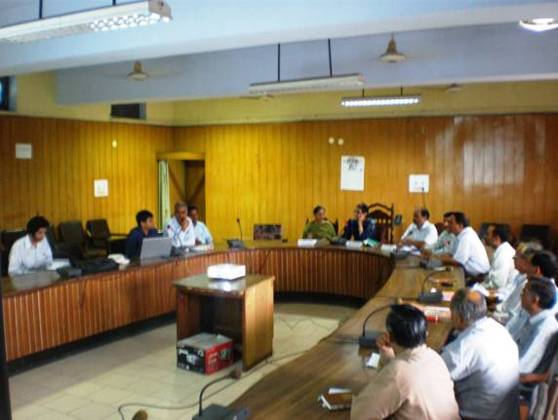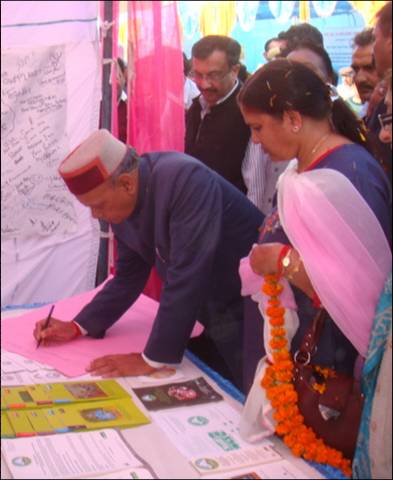CLAP for Himachal: Stepping Stone towards
Carbon Neutrality and Environment Protection
T
he Indian economy is one the fastest growing economies in the world. It stands 12 in terms of the market exchange rate at $1, 242 billion. However, if the cost of climate changes is counted, it would be only 4 to 4.5 per cent per year so far. Today, climate change is one of the greatest challenges confronting the world’s environment, society, as well as the world economy. Its repercussions can be seen across the globe and no country is immune to its hazards.The concept of social development is inclusive of economic development, but differs from it in the sense that it puts more emphasises on the sustainable development. Not only India, but the entire world pays a significant cost against development in terms of ravages of climate change. As a developing country and being the second largest population of the world, India is among the most venerable countries towards the negative consequences of climate changes. India has also contributed around four per cent to the global carbon dioxide emissions. Environmental analysts have identified environmental sustainability as the next great challenge that India faces along in its path to development.
India has around 20 per cent geographical area covered with mountains, the most venerable regions towards climate change. Approximately 90 per cent Himachal is hills. The state is already prone to the ravages of climate change, as is evident in recurrent floods and cloudbursts, falling crop yields, water scarcity etc.
According to an estimate made in climate change report of the Himalayan region, the minimum temperatures are projected to rise by one degree centigrade to 4.5 degrees centigrade and the maximum temperatures may rise by 0.5 degrees to 2.5 degrees centigrade by 2030. The increase in temperatures may lead to increasing morbidity due to heat stress. Flash flooding due to Glacial Lake Outburst Floods (GLOF) may lead to large scale landslides and affect food security and hence nutritional health.
1
Apple cultivation in Himachal has decreased between 1982 and 2005 as the increase in maximum temperature has led to a reduction in total chilling hours in the region. The reduction in total chilling hours was recorded more during the months of November and February. With increasing temperatures, it is anticipated that there may be an all-round decrease in apple production in the Himalayan region and the line of production may shift to higher altitudes also.
The Community Led Assessment Awareness Advocacy Action (CLAP) Programme for Carbon Neutrality and Environment Protection for Himachal has been launched as a peoples’ initiative for empowering the communities to be aware of and address the issues related to climate change in the year 2009. The ‘CLAP for Himachal’ has been launched as the biggest and probably first initiative in India and the world, involving communities and people to reduce carbon emissions and to make them aware of the consequences of climate change. The objectives of the programme are:
1. Systematically assess and document the existing environment quality and carbon foot prints of the Panchayats, Urban local bodies and the causes of degradation and possible ameliorative action
2. Generate systematic awareness among communities, decision-makers, and other stake holders
3. Mobilise communities and Panchayats to undertake environmental improvement actions
4. Establish a vibrant network of Eco-clubs, Mahila Mandals, welfare associations, NGOs, government agencies and other bodies to promote environmental advocacy for policy change at district and State levels
Stepping Milestones
Despite various hurdles and challenges, the programme has achieved a lot since August 2009, in terms of establishing a vibrant network across the state, advocacy through liaison with various departments and district administrations, finalising instruments for assessment processes and pilot assessment exercises in seven Panchayats of various districts of the state.
1. Creation of Primary and Secondary Networks
Under the programme, a network of 65 NGOs has been established in 69 blocks of Himachal Pradesh as core Primary Network Partners. A total of 65 NGOs have signed a Memorandum of Understanding (MoU) under the programme for 69 blocks of the 11 districts of the state. Originally, the operational structure of the programme provisioned for one Lead Implementation Agency (LIA) for every district. At present no LIA has been nominated from those selected for CLAP implementation.
The secondary networks of Mahila Mandals, Eco-clubs and Self Help Groups (SHGs) have been identified through the IAs in 948 Panchayats across the state. This data has been compiled in the Block Implementation Plan (BIP) for every district.
2. Seeking Governance Support: Advocacy and Conversance
To support the programme, District Steering Committees (DSCs) have been formed in all the districts under the chairmanship of respective District Commissioners (DCs). The Project Officer, District Rural Development Agency (DRDA) is the convenor of the programme and the representatives and heads of various district level departments are the members of the district steering committees. The DSCs meetings are held once in two months and opportunities of conversance from various departments with the CLAP programme on panchayat and district levels are discussed and finalised. In Bilaspur, a paper recycling unit by Technology and Action for Rural Action (TARA) has been set up as the result of coordination between CLAP for the Himachal project and district administration Bilaspur. In Mandi and Dharmsala, the district administration has asked for the setting up of a paper recycling unit that is being followed up by TARA.
The introductory district steering committee meetings have been conducted in all the districts and the panchayat action plans of respective districts have to be discussed in the next district steering committee meetings.
3. Awareness: Children Science Congress

The Children’s Science Congress is organised every year as a state level event in Himachal Pradesh. The objective of the congress is to provide science & technology related orientation to the students, aged between 10-17 years and motivate them to pursue Science as a professional option.
This year, the Children’s Science Congress was held at Hamirpur, where the CLAP team participated and organised a signature campaign to promote environment protection. The objective of the campaign was to promote the project and to generate awareness on environment protection among students and participants, using Information Education and Communication (IEC) materials, i.e. pamphlets, brochures, manuals, water and air testing kit demonstrations etc. The congress was inaugurated by Ms Rajwant Sandhu, Chief Secretary, Himachal Pradesh. More than 400 students and teachers/lecturers from Himachal Pradesh participated in the event. Apart from schools, scientists, government officials and enthusiastic people also participated in the congress.
The campaign was attended by Chief Minister, Himachal Pradesh, Prof. Prem Kumar Dhumal, Ms Rajwant Sandhu, Chief Secretary, Ms Sarojini G. Thakur, Additional Chief Secretary and Dr Nagin Nanda, Director, DoEST.
4. Assessment and Action: Sample Panchayat Assessment Exercise
As per the plan of the development phase, the programme is to be started across Himachal Pradesh. Under the programme 846 panchayats of 76 blocks, with additional three implementation areas of all the districts of Himachal Pradesh has to be covered. Ensuring smooth implementation of the programme with objectivity, the instrument for assessment exercise has been designed and tested in seven panchayats of various districts that come under four diverse agro-climatic zones. The process under assessment exercise followed is as under:
4.1. Meeting with Panchayat Representatives
As the entry into the panchayat, the team approaches first to the Panchayati Raj Institution (PRI) members, preferably the Gram Pradhan. Along with the gram pradhan, the team establishes contacts with other PRI members, members of Mahila Mandal, Youth clubs and other prominent resource persons of the panchayat, who are invited to participate in the meeting at a common place of the panchayat.
4.2. Rapid Rural Appraisal
During the reconnaissance, the team members visit various resources available in the panchayat, i.e. Bawadis, check dams etc and document it. The team takes a round of the panchayat and documents their observations. During the recce, the air testing sites and water testing sites are also identified and the villagers are asked to take drinking water sources from identified sites to test and know the quality of their drinking water sources.
4.3. Air Testing
Air sampling stations are set up at sites prone to bad air quality. The stations work for at least eight hours at the place to analyse the samples on site, using the chemicals provided with the portable air testing kits.
4.4. Community Interaction and Administering Questionnaire
A community meeting is held at a common place like the Panchayat Bhawan in order to conduct an Environment/ Carbon assessment exercise. The participants are explained the aims and objective of the programme.
A questionnaire with 47 questions on various indicators is handed over during Focused Group Discussions (FGDs). The answers given by community people are documented and the data is used for analysis and preparation of carbon foot print of the villages.
4.5. Participatory Rural Appraisal
A Participatory Rural Appraisal (PRA) is then conducted.
Information on the location of water sources (wells, ponds, and tanks etc.), drainages and agricultural land, grazing lands, residential sites, forest areas, green houses etc. is given and a PRA map of the panchayat is drawn on a chart paper.
4.6. Water Testing
A Water testing exercise is conducted during the meeting in collaboration with the community. Generally six tests, i.e. pH value, Chlorine, Nitrate, Fluoride, Phosphorus, Iron, Ammonia are performed. The community is asked to carry out the testing exercises with the help of the manuals provide under water testing kits supplied by Development Alternatives. The water testing results are then discussed with the community people suggestions are made.
4.7. Secondary Data Collection
The primary information is validated through secondary information from the respective departments.
4.8. Data Analysis and Preparation of Panchayat Action plan
The data received through the primary and secondary sources are analysed and the inferences are drawn to compile the Panchayat Action Plan.
Summary
The project has completed one and half years and entered into the developmental phase of the programme. In the developmental phase, there is a plan to start the implementation of the programme in all the districts across Himachal Pradesh. development Alternatives believes that after completing three years, the programme will lay the foundation stone for carbon neutrality and environment protection in Himachal Pradesh. It will also prove a model for other states of the country. q
Satyendra Nath Pandey
snpandey@devalt.org
(Footnotes)